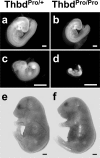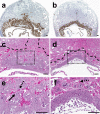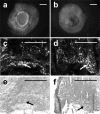Fetal gene defects precipitate platelet-mediated pregnancy failure in factor V Leiden mothers
- PMID: 17438064
- PMCID: PMC2118565
- DOI: 10.1084/jem.20062566
Fetal gene defects precipitate platelet-mediated pregnancy failure in factor V Leiden mothers
Abstract
We describe a mouse model of fetal loss in factor V Leiden (FvL) mothers in which fetal loss is triggered when the maternal prothrombotic state coincides with fetal gene defects that reduce activation of the protein C anticoagulant pathway within the placenta. Fetal loss is caused by disruption of placental morphogenesis at the stage of labyrinth layer formation and occurs in the absence of overt placental thrombosis, infarction, or perfusion defects. Platelet depletion or elimination of protease-activated receptor 4 (Par4) from the mother allows normal placentation and prevents fetal loss. These findings establish a cause-effect relationship for the observed epidemiologic association between maternal FvL status and fetal loss and identify fetal gene defects as risk modifiers of pregnancy failure in prothrombotic mothers. Pregnancy failure is mediated by Par4-dependent activation of maternal platelets at the fetomaternal interface and likely involves a pathogenic pathway independent of occlusive thrombosis. Our results further demonstrate that the interaction of two given thrombosis risk factors produces markedly disparate consequences on disease manifestation (i.e., thrombosis or pregnancy loss), depending on the vascular bed in which this interaction occurs.
Figures





Similar articles
-
The relationship of the factor V Leiden mutation and pregnancy outcomes for mother and fetus.Obstet Gynecol. 2005 Sep;106(3):517-24. doi: 10.1097/01.AOG.0000173986.32528.ca. Obstet Gynecol. 2005. PMID: 16135581
-
Activated protein C resistance -- in the absence of factor V Leiden -- and pregnancy.J Thromb Haemost. 2006 Feb;4(2):361-6. doi: 10.1111/j.1538-7836.2006.01714.x. J Thromb Haemost. 2006. PMID: 16420566
-
Factor V Leiden and fetal loss in a 33-year-old Tunisian woman.East Mediterr Health J. 2003 May;9(3):472-5. East Mediterr Health J. 2003. PMID: 15751941 No abstract available.
-
[Factor V Leiden mutation and pregnancy complications].Medicina (Kaunas). 2003;39(9):823-9. Medicina (Kaunas). 2003. PMID: 14515043 Review. Lithuanian.
-
[Prevalence of factor V Leiden, hyperhomocysteinemia, prothrombin G20210A, and methylene tetrahydrofolate reductase C677T mutations in obstetrical complications].Ann Biol Clin (Paris). 1999 Sep-Oct;57(5):539-44. Ann Biol Clin (Paris). 1999. PMID: 10518055 Review. French.
Cited by
-
Sex differences in thrombosis in mice are mediated by sex-specific growth hormone secretion patterns.J Clin Invest. 2008 Aug;118(8):2969-78. doi: 10.1172/JCI34957. J Clin Invest. 2008. PMID: 18618017 Free PMC article.
-
Protease-Activated Receptor 4 (PAR4): A Promising Target for Antiplatelet Therapy.Int J Mol Sci. 2018 Feb 14;19(2):573. doi: 10.3390/ijms19020573. Int J Mol Sci. 2018. PMID: 29443899 Free PMC article. Review.
-
Combined tissue factor pathway inhibitor and thrombomodulin deficiency produces an augmented hypercoagulable state with tissue-specific fibrin deposition.J Thromb Haemost. 2008 Jan;6(1):111-7. doi: 10.1111/j.1538-7836.2007.02817.x. Epub 2007 Oct 25. J Thromb Haemost. 2008. PMID: 17973652 Free PMC article.
-
Management of inherited thrombophilia in pregnancy.Womens Health (Lond). 2016 Jul;12(4):433-41. doi: 10.1177/1745505716653702. Womens Health (Lond). 2016. PMID: 27638899 Free PMC article. Review.
-
Variable phenotypic penetrance of thrombosis in adult mice after tissue-selective and temporally controlled Thbd gene inactivation.Blood Adv. 2017 Jun 27;1(15):1148-1158. doi: 10.1182/bloodadvances.2017005058. Epub 2017 Jun 23. Blood Adv. 2017. PMID: 28920104 Free PMC article.
References
-
- Dudding, T.E., and J. Attia. 2004. The association between adverse pregnancy outcomes and maternal factor V Leiden genotype: a meta-analysis. Thromb. Haemost. 91:700–711. - PubMed
-
- Rey, E., S.R. Kahn, M. David, and I. Shrier. 2003. Thrombophilic disorders and fetal loss: a meta-analysis. Lancet. 361:901–908. - PubMed
-
- Kovalevsky, G., C.R. Gracia, J.A. Berlin, M.D. Sammel, and K.T. Barnhart. 2004. Evaluation of the association between hereditary thrombophilias and recurrent pregnancy loss: a meta-analysis. Arch. Intern. Med. 164:558–563. - PubMed
-
- Mousa, H.A., and Z. Alfirevic. 2000. Do placental lesions reflect thrombophilia state in women with adverse pregnancy outcome? Hum. Reprod. 15:1830–1833. - PubMed
-
- Sikkema, J.M., A. Franx, H.W. Bruinse, N.G. van der Wijk, H.W. de Valk, and P.G. Nikkels. 2002. Placental pathology in early onset pre-eclampsia and intra-uterine growth restriction in women with and without thrombophilia. Placenta. 23:337–342. - PubMed
Publication types
MeSH terms
Substances
Grants and funding
LinkOut - more resources
Full Text Sources
Medical
Molecular Biology Databases

